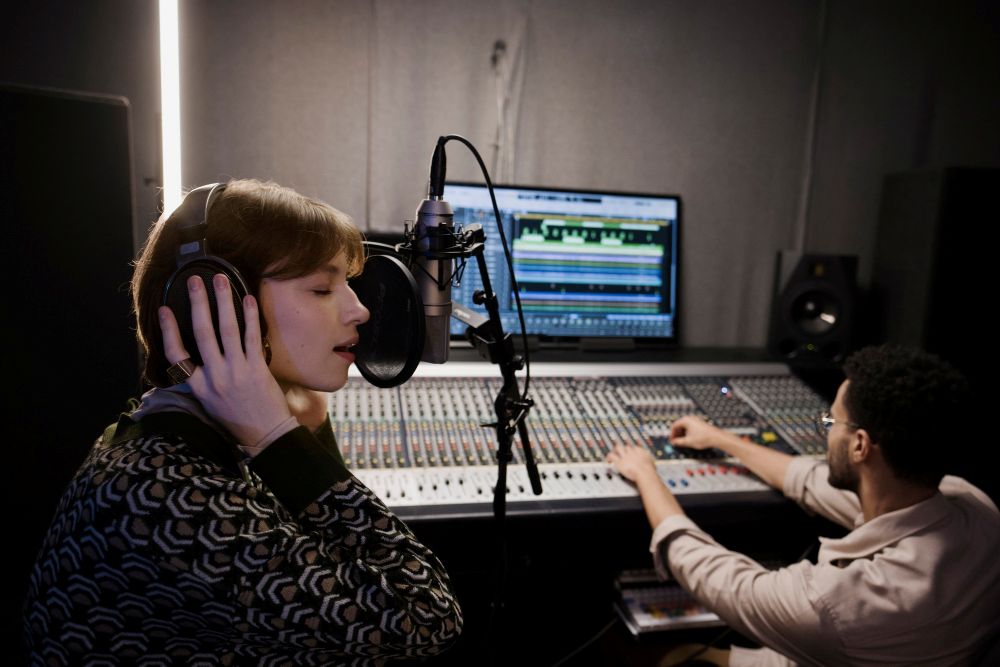
The media universe is full of voiceovers. These well-crafted recordings bring stories to life. Voiceover recordings are used to enrich everything from YouTube vlogs to animated productions.
After creating an instructional or how-to video, you can perfect it using a top-quality voiceover recording.
You can make your video sound great without having a professional studio or voiceover training. With the right knowledge, preparation, and equipment, anyone can create an excellent voiceover.
This article explores the ins and outs of creating top-quality voiceover recordings.
What is a Voiceover Recording?
Voiceover can be defined as the use of an off-camera voice to add context or narrate a scene. Voiceovers in the form of dialogue, commentary, or narration have been used in film, radio, and TV for ages.
A voiceover is different from voice acting in a number of ways. For starters, voiceovers do not embody a character. Secondly, voiceovers are primarily meant to inform the audience/listener. Lastly, while they can be emotive, voiceovers tend to be more tempered as the main goal is to communicate specific information.
These recordings have been used to express the inner thoughts of characters, provide backstories, and narrate stories.
Technological advancements leading to better editing and clearer audio have significantly improved the versatility and quality of voiceovers.
Importance of Voiceover Recordings
The audio component of a video is just as important as the video element. While the visual element is critical, a high-quality voiceover makes your video easier for viewers to understand what they are seeing. Viewers are likely to be frustrated by low-quality, muffled, or garbled sound. Clear audio is also critical for communicating to visually impaired people who value the information in your video.
Essentials of A Good Voiceover Recording
Just about anyone can produce a top-quality voiceover. Some of the main elements of good voiceovers include:
– Diction: You must pronounce every word properly in order to be understood. Avoid shouting and mumbling when recording voiceovers. While you are not expected to sound like a seasoned actor, try your best to speak clearly and naturally.
– Pacing: A good voiceover is not so slow that it seems to drag on forever and feel boring. It is also not so fast that listeners feel rushed. It should have a natural and deliberate pace.
– Volume and Audio Clarity: You should always use a comfortable volume and keep your voice clear when recording audio. Viewers are likely to be distracted and will find it hard to understand what you are saying if you sound muddy or fuzzy.
– Inflection and Vocal Tone: Good voiceovers should sound engaging and friendly. However, avoid overdoing it as it might make you sound fake!
How to Record a Voiceover
Here’s a breakdown of the steps to follow when recording a voiceover.
1. Write a Script
The first and most important step in voiceover recording involves preparing a script. With a well-crafted script, you can steer clear of any unnecessary and awkward pauses between words when recording. A good script can save you a lot of effort during editing by ensuring that you record using consistent and natural pacing throughout.
Take some time to think about everything you want to say and put it all down in the script. Before you start recording, remember to read the script out loud and practice a few times. This will help you identify and make any improvements that can boost the quality of the final recording.
2. Get the Right Equipment
A good microphone is essential to recording high-quality voiceovers. Avoid using the in-built microphone in your laptop as it is likely to produce muffled sounds. Consider investing in an affordable external microphone equipped with a pop filter designed to minimize unwanted sounds.
If you can’t afford an external microphone, you can use headphones with an in-built mic. Alternatively, you can use your phone’s microphone. Just remember to soften your voice by covering the phone with a sock.
3. Choose a Location
The location where you choose to record your voiceovers plays an important part in the quality of the resulting material. While you may not need a professional studio, make sure that you pick a space where you can record without any interruptions.
Ensure that the audience only hears your voice by avoiding places with people’s voices, ambient sounds, and environmental noise.
4. Conduct a Test Recording
Check your equipment and audio quality with a test run. Remember that you don’t have to record the entire script during the test. Just read out a few sentences and listen back to see if everything is in order.
Work on your microphone technique by recording a few tests at different positions and distances. Positioning the mic too far may make the recording unclear while keeping it too close may result in unwanted sounds.
Use quality headphones when listening back to the test recordings to ensure that you pick up on any unnecessary noises and sounds.
5. Create the Voiceover Recording
Once everything is ready, you can get down to recording your voiceover. When you start recording, remember to use a clear and steady voice. If you are reading from a script, avoid using a monotonous tone and instead keep it as natural as possible.
No recording is perfect, and if you make any mistakes during the recording phase, just continue and sort them out during editing. However, if you make big mistakes, you might be better off starting over to save yourself from ending up with a significant amount of unusable material.
6. Post Production
Once you are done with recording, sit down and edit the file. You can add any effects deemed necessary, adjust volume levels, and remove unwanted noises. This step of the recording process also involves trimming the video to match it to the audio file. The same techniques are used by DJs to produce music with vocals.
Start Recording High-Quality Voiceovers
A quality voiceover can help make your video easier to understand. Voiceovers narrate or add context to video scenes. You don’t need to be a professional to record high-quality voiceovers. With the right planning, preparation, and execution, anyone can create quality voiceovers right from the comfort of their home.
Transform your instructional videos by creating captivating voiceovers by following the above process!





